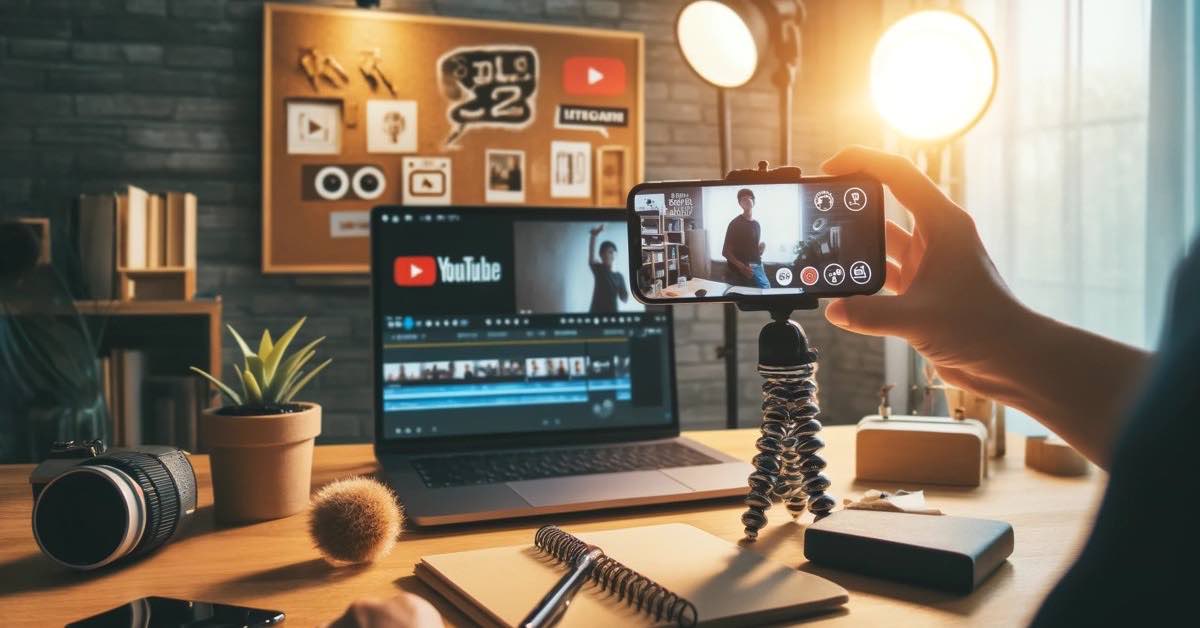Video marketing has become an indispensable tool for small businesses, providing a dynamic way to engage with audiences, increase brand awareness, and drive conversions. With the right strategy, even businesses with limited budgets can create compelling video content that resonates with their target audience.

Understanding Your Audience
Knowing your audience is the cornerstone of any successful marketing campaign, including video marketing. Understanding who your audience is, what they like, and what they need allows you to create content that speaks directly to them.
Importance of Knowing Your Target Audience
Tailoring your content to your audience’s preferences increases the likelihood of engagement and conversion. When you understand your audience, you can address their pain points, answer their questions, and provide value, making your videos more impactful.
Techniques for Researching and Defining Your Audience
- Surveys and Feedback
- Conduct online surveys to gather insights into your audience’s preferences and interests.
- Encourage customer feedback through emails or social media to understand their needs better.
- Analysing Competitors
- Observe your competitors’ video content to see what resonates with their audience.
- Identify gaps in their content that you can fill with your videos.
- Social Media Insights
- Use analytics tools provided by social media platforms to gather data on your audience’s demographics and behaviour.
- Monitor engagement metrics like likes, shares, and comments to understand what type of content your audience enjoys.
Setting Clear Objectives
Setting clear objectives for your video marketing campaign is crucial to ensure that your efforts are aligned with your business goals. By defining what you want to achieve, you can create focused and effective video content.
Defining Goals for Your Video Marketing Campaign
- Brand Awareness
- Create videos that introduce your brand, mission, and values.
- Use storytelling to make your brand memorable and relatable.
- Lead Generation
- Produce content that educates and informs, prompting viewers to subscribe, sign up, or download resources.
- Use clear calls to action (CTAs) to guide viewers towards taking the next step.
- Sales and Conversions
- Develop product demos and tutorials to showcase your offerings and their benefits.
- Include customer testimonials to build trust and credibility.
Having well-defined objectives not only guides your content creation but also provides a benchmark for measuring success.
Types of Videos to Create
Creating a variety of video types can help keep your audience engaged and cater to different stages of the customer journey. Here are some types of videos that are particularly effective for small businesses:
Explainer Videos
- Purpose: Simplify complex concepts or processes related to your products or services.
- Benefit: Helps potential customers understand how your offerings can solve their problems.
Product Demos
- Purpose: Showcase the features and benefits of your products.
- Benefit: Provides a visual and practical understanding, increasing the likelihood of purchase.
Customer Testimonials
- Purpose: Share real experiences from satisfied customers.
- Benefit: Builds trust and authenticity, as potential customers see real-life endorsements.
Behind-the-Scenes Footage
- Purpose: Give a glimpse into your company’s culture, processes, or daily operations.
- Benefit: Humanises your brand and fosters a deeper connection with your audience.
Live Streams
- Purpose: Engage with your audience in real-time through Q&A sessions, product launches, or events.
- Benefit: Creates a sense of immediacy and personal interaction, boosting engagement.
Budget-Friendly Video Production Tips
Producing high-quality videos doesn’t have to be expensive. With careful planning and resourcefulness, you can create impactful videos on a budget.
Planning and Scripting Your Videos Effectively
- Write clear and concise scripts to keep your videos focused and engaging.
- Plan your shots and sequences to streamline the filming process and reduce unnecessary costs.
Utilising Low-Cost Equipment and Tools
- Smartphones and Affordable Cameras: Modern smartphones often have excellent video capabilities. For higher quality, consider entry-level cameras.
- Free or Low-Cost Video Editing Software: Tools like iMovie, DaVinci Resolve, and HitFilm Express offer robust editing features without a high price tag.
Leveraging DIY Production Techniques
- Setting Up a Mini-Studio: Use a quiet room with good natural light. A simple backdrop can enhance the professionalism of your videos.
- Lighting Solutions: Utilize natural light when possible. Inexpensive LED lights or softboxes can improve video quality without breaking the bank.
Storytelling Techniques

Storytelling is a powerful way to connect with your audience. By crafting a compelling narrative, you can make your videos more engaging and memorable.
Crafting a Compelling Story for Your Videos
- Focus on the human element to make your story relatable.
- Highlight the journey of your brand, products, or customers.
Importance of Authenticity and Relatability
- Be genuine in your storytelling. Audiences can tell when a story is contrived.
- Relate to your audience’s experiences and emotions to foster a deeper connection.
Structuring Your Video Content
- Hook: Grab attention in the first few seconds.
- Problem Statement: Clearly define the issue or need.
- Solution: Present your product or service as the solution.
- Call to Action: Encourage viewers to take a specific action, such as visiting your website or making a purchase.
Leveraging Social Media Platforms
Choosing the right social media platforms for your video content is crucial to reach your target audience effectively. Each platform has its own strengths and best practices, so it’s important to tailor your content accordingly.
Choosing the Right Platforms for Your Videos
- YouTube
- Strengths: The largest video-sharing platform, ideal for long-form content.
- Best Practices: Optimise titles, descriptions, and tags for searchability. Create custom thumbnails to attract clicks.
- Facebook
- Strengths: Great for reaching a broad audience with both short and long videos.
- Best Practices: Use Facebook Premier for scheduled video posts, engage with comments, and use captions to increase accessibility.
- Instagram
- Strengths: Highly visual platform suitable for short, engaging videos.
- Best Practices: Utilise Instagram Stories and Reels for short, impactful content. Use hashtags to increase discoverability.
- TikTok
- Strengths: Perfect for short, viral videos with a younger audience.
- Best Practices: Focus on trends and challenges, use engaging visuals and music, and keep videos under 60 seconds.
Tips for Optimising Videos for Each Platform
- Video Length: Adapt the length of your videos to fit the platform. For example, keep Instagram Reels and TikTok videos short (15-60 seconds), while YouTube allows for longer, more detailed content.
- Format and Aspect Ratios: Ensure your videos are formatted correctly. Vertical videos work well on Instagram Stories and TikTok, while horizontal videos are best for YouTube and Facebook.
- Posting Times and Frequency: Research the best times to post on each platform for maximum engagement. Consistency is key, so establish a regular posting schedule.
SEO Strategies for Video Content
Search Engine Optimisation (SEO) is not just for written content. Applying SEO techniques to your videos can significantly improve their visibility and reach.
Importance of Video SEO
Optimising your video content ensures that it appears in search results, increasing the chances of discovery by potential customers. Effective video SEO can lead to higher engagement rates and better overall performance of your marketing efforts.
Optimising Video Titles, Descriptions, and Tags
- Titles
- Use clear, descriptive titles that include relevant keywords.
- Keep titles concise and compelling to encourage clicks.
- Descriptions
- Write detailed descriptions that provide context and include keywords naturally.
- Add links to your website, social media, and other related content.
- Tags
- Use a mix of broad and specific tags to improve discoverability.
- Research popular tags in your niche to include relevant ones.
Using Transcripts and Captions for Better Searchability
- Transcripts: Providing a text transcript of your video helps search engines understand the content, improving its search ranking.
- Captions: Adding captions not only makes your videos accessible to a wider audience but also enhances SEO by providing additional text for search engines to index.
Measuring Success and ROI

Tracking the performance of your video marketing efforts is essential to understand what works and to refine your strategy.
Key Metrics to Track the Performance of Your Videos
- Views: Measure the number of times your video has been watched.
- Engagement: Track likes, comments, shares, and watch time to gauge audience interaction.
- Conversion Rates: Analyse how many viewers take the desired action, such as visiting your website or making a purchase.
Tools and Techniques for Analysing Video Performance
- Google Analytics
- Use Google Analytics to track how your videos drive traffic and conversions on your website.
- Monitor user behaviour and engagement with your video content.
- Platform-Specific Insights
- YouTube Analytics: Provides detailed metrics on views, watch time, and audience demographics.
- Facebook Insights: Offers data on video reach, engagement, and performance.
Regularly reviewing these metrics will help you understand the impact of your video marketing and identify areas for improvement.
Real-Life Success Stories
Learning from the success of other small businesses can provide valuable insights and inspiration for your own video marketing efforts.
Case Studies of Small Businesses That Have Succeeded with Video Marketing
- Company A: Local Bakery
- Strategy: Utilised Instagram Stories to showcase daily specials and behind-the-scenes footage.
- Results: Increased customer engagement and foot traffic to their physical store.
- Company B: Online Retailer
- Strategy: Created product demo videos and shared them on YouTube and Facebook.
- Results: Boosted online sales and improved customer trust through detailed product demonstrations.
Key Takeaways and Lessons Learned from These Examples
- Consistency: Regular posting and engagement are key to building an audience.
- Authenticity: Genuine, relatable content resonates more with viewers.
- Adaptability: Tailoring content to fit different platforms can enhance reach and effectiveness.
Practical Next Steps for Small Businesses
To get started with video marketing, small businesses can take several actionable steps to ensure success.
Actionable Tips for Getting Started with Video Marketing
- Start Small: Begin with simple, low-cost videos and gradually invest more as you see results.
- Plan Ahead: Outline your video content calendar to ensure consistency.
- Engage with Your Audience: Respond to comments and feedback to build a loyal community.
- Analyse and Adjust: Regularly review your metrics and refine your strategy based on performance.
Resources and Tools for Further Learning and Development
- Online Courses: Platforms like Udemy and Coursera offer courses on video production and marketing.
- Video Editing Software: Explore tools like Adobe Premiere Pro, Final Cut Pro, or free alternatives like DaVinci Resolve.
- Community Forums: Join online communities and forums to exchange tips and experiences with other small business owners.
By following these steps and utilising the resources available, small businesses can create impactful video content that drives engagement and growth, even on a budget.


